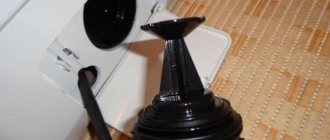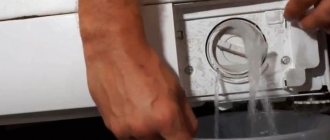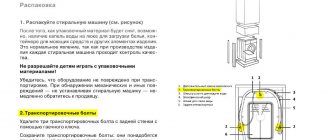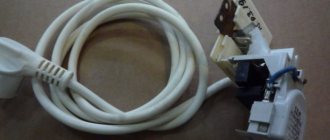Any washing machine, regardless of brand, has a filter that protects the drain pump from foreign objects. During operation, it becomes clogged, which leads to poor water drainage. The problem is solved by removing debris from the filter element. You can do the work yourself, but to do this you need to know where it is and how to clean the filter in an automatic washing machine (WMA)?
Types of filters and their purpose
The normal functioning of the washing machine is ensured by two main and one additional filter:
- mesh filter element of the filler pipe;
The inlet filter is an ordinary metal or polymer mesh with cells of a few tenths of a millimeter, designed to block the path of small particles of plumbing debris into the washing system.
Most often, the inlet mesh element becomes clogged, since it is installed directly at the water inlet into the washing machine.
- drain filter;
The drain filter (main) is a round, oblong plastic plug screwed into a volute designed to protect the drain pump impeller from foreign objects in the form of: toothpicks, matches, buttons and the like.
- water filter for water softening (purchased and installed separately)
The plumbing systems of our apartment buildings leave much to be desired, so the water entering the washing machine may contain pieces of rust, sand and other small particles, the penetration of which into the washing unit is extremely undesirable. Such an abrasive can not only have a negative effect on the mechanical part of the washing machine, but can also lead to damage to things. In addition, rust stains that appear from rust are sometimes completely impossible to wash off.
Where are the drain and fill filters located?
The location of the filters for most household washing units is the same. The filling filter element is installed in the rear (top) part of the washing unit, directly on the inlet fitting of the water supply valve.
The drain filter must be looked for at the lowest point of the washing machine; it is there that the water can be drained by gravity in the event of an emergency. Most often, access to it is closed by a special hatch or decorative panel; for ease of maintenance, it is located in the front part of the machine. In the same place there may be a small-diameter emergency drain pipe with a plug at the end in the form of a plug. This tube is designed for emergency drainage of water from the washing machine tank.
Features of the location of the drain filter from different manufacturers
The main criterion that manufacturers follow when installing a drain filter is easy access to it for maintenance. It can be located on the front (most models) or side (for example Samsung) side. Typically, the pipe into which the filter element is screwed is made together with the drain pump body; when the pump is removed, the element itself is accordingly removed. In order to get to it, you must either remove the decorative trim, or open or slide a special door.
Signs of blockages
You can identify the presence of a blockage in the drain filter by the following signs:
- The machine does not turn on and gives an error. The error code can be anything, but it is important to make sure that the device is correctly connected to the water supply and electrical network, and that the drain hose is located at the correct angle;
- the time for draining water increases due to its prolonged removal from the drum or at the end of the cycle the laundry remains wet, and a small amount of liquid is present inside the tank;
- The “Spin” or “Rinse” functions do not work.
Seeing signs on your device?
Not really
How to remove and clean the drain filter
If it turns out that after spinning the clothes are very wet, and the washing cycle itself lasts longer than the allotted time, then the problem may be that the drain pump is blocked. The cause could be anything from a torn button from a garment to an underwire from a bra. To unlock the pump, you must first remove the drain filter. It is at the location of the drain filter element that all the debris collects.
Before unscrewing the part, it is worth preparing a container for water and a rag. If the washing machine was in operation, there will definitely be a small amount of water in the drain system. If the filter has to be cleaned in emergency mode, when the water has not drained from the washing tank, then a larger container for collecting water must be taken.
Having placed a towel and placed a container under the drain hole, you can begin to unscrew. Under normal conditions, the filter should unscrew freely counterclockwise after a little effort. By pulling it towards you, it is necessary to remove foreign objects and remaining contaminants from it.
Be sure to look into the drain hole and assess the condition of the drain pump impeller!
If objects get into a running pump, it can be damaged, and pieces of flying plastic can block the operation of the entire pump. If there are no items, the part can be put back.
Before installation, it would be a good idea to check the condition of the rubber gasket on the filter housing. After 3-5 years of operation, the rubber becomes rough and cracks under the influence of temperature and detergents. This may lead to unwanted leakage. It is twisted clockwise until it stops, with little effort.
Do not unscrew or tighten the drain filter with pliers, as you can break its internal parts and damage the threads. All these procedures are performed by hand!
How to remove and clean the fill filter
Almost all modern units are equipped with a mesh fill filter. To gain access to it, you need to disconnect the inlet hose from the washing machine, first turning off the water supply tap.
To equalize the pressure, it is best to wait a few minutes and only then unscrew the hose nut.
Before unscrewing the hose, it is necessary to place a small cloth under the fitting so that residual water does not fall on the back wall of the machine or the floor. Using pliers, grab the filter by the protruding part and pull it towards you. After removal, you need to inspect the mesh for dirt, and if necessary, clean it under running water using an old toothbrush.
A clogged inlet filter can be judged by a small pressure or no water flow at all; when you start washing, powder is poured into the tray. In addition, there are washing units equipped with indicators warning of filter clogging.
Cleaning options
A standard filter usually gets clogged every six months, at which time it needs to be pulled out and cleaned manually. To avoid any problems during the process, some people prefer to rinse the part under running warm water. If there is severe contamination, clean it with a regular toothbrush, and also soak it for several hours in water with the addition of citric acid to remove excess limescale and bad odor.
- remove all laundry and unplug the device;
- find the location of the part and the panel cover;
- Having opened the lid, carefully remove the part;
- completely clean the filter located there and the hole itself where it is inserted;
- After cleaning, place it back and close the lid.
What to do if the drain filter cannot be removed
If you cannot unscrew the drain filter with normal force, then it is better to disassemble the entire pump unit. The reason for its blockage can also be an object that has fallen into its cavity, and without removing the pump, it will not be possible to remove it from there. To troubleshoot the problem you must:
- Disconnect the washing machine from the power supply and water supply;
- Remove protective decorative elements and provide access to the drain pump housing;
- Unscrew all the bolts, nuts and screws that secure the drain pipe and pump to the body of the washing unit;
- Loosen and push back the clamps securing the drain pipe and drain hose to the pump body;
- Remove the pipe and hose;
- Inspect the filter cavity through the pipes, and if there are foreign objects, remove them.
In order to remove a stuck object, sometimes it is enough to simply shake the pump, and the button or paper clip stuck there will fall out through the hole in the nozzle. Otherwise, you can use a screwdriver or tweezers.
Why can’t I unscrew and remove the filter?
The main enemy of all mechanical parts of a washing machine is water with detergents and salts dissolved in it. During operation, under the influence of temperature, these substances are deposited on the walls of all elements involved in the washing process. This, in turn, disrupts their work. If the filter elements have not been unscrewed for a long time, salts deposited on the threads of the filter housing and drain pipe can cause them to block. The part may also not unscrew if there is a foreign object between its body and the impeller.
All the ways to open and remove the drain filter
To remove the drain filter from the drain pipe, sometimes you can do without removing the pump. If the filter can be unscrewed at least half a turn, you should try to unscrew it “back and forth” with gentle movements. If the body is blocked by scale, then it is destroyed, and then this method works. If some “trifle” gets in the way, its position in the body may change and the part can be unscrewed.
Cleaning products used
To remove plaque and debris, simple products are used that are found in any home. If it is not possible to cope with the clogged drain filter using traditional methods, industrial methods are used. Our tips will help you thoroughly clean the unit, ensuring high-quality operation of the washing machine.
Folk
These methods combine the mechanical removal of debris from the surfaces of the device and the removal of its residues using water and a solution of citric acid. The abrasive side of the sponge helps clean the filter from plaque. Warm water washes away dirt and mineral deposits removed by the sponge. Using citric acid, it is often possible to clear deposits on the threads that prevent the filter from being unscrewed.
Industrial
Cleaning the threads of the drain filter from deposits with citric acid is convenient, but not always effective. If soaking in its solution does not give the desired effect, you should replace the unit with a new one. Using wire cutters, carefully break the filter and remove any remaining plastic from the volute thread. You can install a new unit only if its integrity is completely preserved. If the thread is damaged, the tightness of the connection will be compromised. In this case, you need to replace the filter device along with the pump volute.
What to do if the filter is leaking
If a puddle of water has formed at the bottom of the machine, there may be three reasons for the leak:
- violation of the integrity of the gasket;
- crack in the pump drain pipe;
- crack in the filter cover.
If the gasket becomes unusable, it is replaced with a new one. If a crack forms in the cover, you should buy a new one and install it in place. A crack in the body of the pump drain pipe leads to either replacing the pipe or replacing the entire pump if it has a non-demountable body.
When carrying out all maintenance work on the washing machine, and even more so when carrying out repairs, it is always necessary to disconnect it from the power supply.
In the case of servicing the filler filter, at a minimum, turn off the water supply valve. Keeping the filters clean is the key to trouble-free operation of the washing unit for many years.











